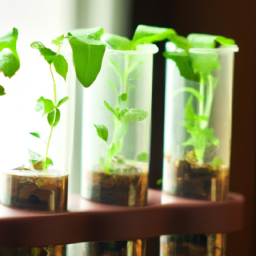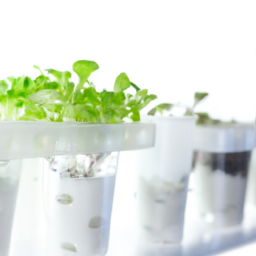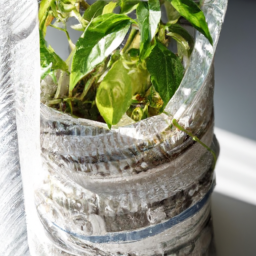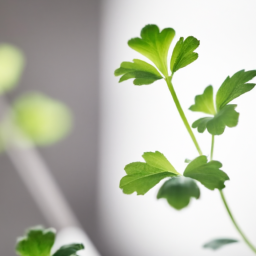
Are you interested in growing your own plants but lack the space or resources for a traditional garden? Look no further than hydroponics at home: modern growing made simple. Hydroponics is a method of growing plants without soil, using nutrient-rich water instead. It’s a revolutionary approach that allows you to cultivate a wide variety of plants right in the comfort of your own home. In this blog post, we will explore the basics of hydroponics, the benefits it offers, and how you can get started with this innovative gardening technique. Whether you’re a seasoned gardener or a beginner with a green thumb, hydroponics at home is an exciting and accessible way to nurture your own thriving garden.
Benefits of Hydroponics for Home Gardening
Hydroponics is a modern and innovative way of growing plants without soil. It offers numerous benefits for home gardening enthusiasts, allowing them to grow a wide variety of plants in a controlled environment. In this article, we will explore the advantages of hydroponics and how it can simplify the process of growing plants at home.
1. Increased Plant Growth and Yield
One of the significant benefits of hydroponics is its ability to promote faster and healthier plant growth. By providing plants with an optimal balance of nutrients and water directly to their roots, hydroponics eliminates the need for plants to search for nutrients in the soil. This results in accelerated growth rates and higher yields compared to traditional soil-based gardening.
Moreover, hydroponics allows for precise control over the growing conditions, including temperature, light, and pH levels. This enables plants to thrive in an ideal environment, maximizing their growth potential. With the right combination of nutrients and environmental factors, home gardeners can enjoy bountiful harvests throughout the year.
In addition to faster growth and increased yields, hydroponics also reduces the risk of plant diseases and pests. Since hydroponic systems are soilless, they eliminate the potential for soil-borne diseases and pests that commonly affect traditional gardens. This means less time and effort spent on pest control and a lower chance of losing plants to diseases.
2. Water Efficiency
Water scarcity is a significant concern in many regions, making efficient water usage crucial for sustainable gardening. Hydroponics is an excellent solution for conserving water while still providing plants with the necessary hydration. Unlike traditional gardening methods that require large amounts of water to saturate the soil, hydroponics recirculates and reuses water, significantly reducing water consumption.
In a hydroponic system, plants are grown in a nutrient-rich water solution that is continuously recirculated. This means that the water is not lost or wasted through drainage, evaporation, or absorption by surrounding soil. By recycling the water, hydroponics can save up to 90% more water compared to traditional soil-based gardening methods.
Furthermore, the controlled environment of hydroponics allows for precise monitoring and adjustment of water levels. This eliminates the risk of overwatering or under-watering plants, ensuring optimal hydration for their growth. With water being a precious resource, adopting hydroponics for home gardening is a sustainable choice that helps conserve water.
3. Space Efficiency
For many home gardeners, limited space can be a significant constraint. However, hydroponics offers a solution by allowing plants to be grown vertically or in compact systems, making the most of available space. Unlike traditional gardens that require ample space for root systems to spread out, hydroponics utilizes a nutrient solution that directly feeds the plants’ roots, eliminating the need for extensive root systems.
Vertical hydroponic systems, such as vertical towers or wall-mounted setups, enable gardeners to grow a large number of plants in a small footprint. This is particularly advantageous for urban dwellers or those with limited outdoor space. Additionally, hydroponic systems can be set up indoors, making it possible to grow plants year-round regardless of weather conditions.
Moreover, the controlled environment of hydroponics eliminates the need for weeding, as there is no soil to support unwanted plant growth. This saves both time and effort, allowing home gardeners to focus on nurturing their desired plants without the hassle of dealing with weeds.
In conclusion, hydroponics offers numerous benefits for home gardening enthusiasts. From increased plant growth and yields to water and space efficiency, hydroponics simplifies the process of growing plants at home. By adopting this modern growing technique, gardeners can enjoy fresh produce, maximize their harvests, and contribute to sustainable gardening practices.

Essential Equipment and Set-up for a Hydroponic System at Home
Introduction
Welcome to the world of hydroponics, where modern growing techniques make it possible to cultivate plants without soil. If you’re interested in setting up your own hydroponic system at home, you’re in the right place. In this guide, we’ll walk you through the essential equipment you’ll need and the step-by-step process to get started. So, let’s dive in and discover how you can grow your own plants using hydroponics!
Choosing the Right Equipment
When it comes to hydroponics, having the right equipment is crucial for success. Here are the essential components you’ll need to set up your own hydroponic system:
1. Grow Lights: Since plants won’t be receiving natural sunlight, you’ll need to provide them with artificial lighting. LED grow lights are the most popular choice due to their energy efficiency and ability to provide the right spectrum of light for optimal plant growth.
2. Growing Medium: Instead of soil, hydroponics uses a growing medium to support the plants’ roots. Common options include perlite, vermiculite, coconut coir, or Rockwool cubes. Choose a medium that retains moisture while allowing for proper drainage.
3. Nutrient Solution: In hydroponics, plants receive their nutrients from a liquid solution. You can purchase pre-mixed nutrient solutions or create your own using a hydroponic nutrient mix and water. It’s important to monitor and adjust the nutrient levels regularly to ensure your plants are getting the right balance of nutrients.
4. Reservoir and Pump: A reservoir is where you’ll store the nutrient solution, and a pump is needed to circulate the solution to the plants. Choose a reservoir size that suits the scale of your hydroponic system and ensure the pump has enough power to distribute the solution effectively.
5. pH and EC Meters: Monitoring the pH and electrical conductivity (EC) of your nutrient solution is crucial for maintaining optimal plant health. pH meters help you adjust the acidity or alkalinity of the solution, while EC meters measure the nutrient concentration. These tools ensure your plants receive the right balance of nutrients for healthy growth.
Setting Up Your Hydroponic System
Now that you have all the necessary equipment, it’s time to set up your hydroponic system. Follow these steps to get started:
Step 1: Choose a Suitable Location: Find a suitable location in your home that receives adequate light and has enough space for your hydroponic system. Ensure there’s access to electricity and water nearby.
Step 2: Assemble the Grow Lights: Install the LED grow lights above your plants, ensuring they are positioned at the right height and angle to provide uniform lighting. Refer to the manufacturer’s instructions for specific guidelines.
Step 3: Prepare the Growing Medium: If you’re using a medium like Rockwool cubes, soak them in water to remove any impurities. If using perlite or coconut coir, ensure they are well-moistened before placing your plants.
Step 4: Mix the Nutrient Solution: Follow the instructions on your hydroponic nutrient mix to create the appropriate solution. Measure the pH and EC levels and adjust them if necessary.
Step 5: Set Up the Reservoir and Pump: Place the reservoir in a convenient location and connect the pump. Ensure the pump is submerged in the nutrient solution and test it to ensure proper circulation.
Step 6: Plant Your Seeds or Seedlings: Gently place your seeds or seedlings into the growing medium, making sure the roots are in contact with the nutrient solution. Maintain proper spacing between plants to allow for optimal growth.
Step 7: Monitor and Adjust: Regularly monitor the pH and EC levels of your nutrient solution and adjust as needed. Keep an eye on plant health, checking for any signs of nutrient deficiencies or pests. Make necessary adjustments to ensure your plants thrive.
Conclusion
Setting up a hydroponic system at home may seem daunting at first, but with the right equipment and a step-by-step approach, it can be a rewarding and efficient way to grow plants. By choosing the right equipment, setting up your system correctly, and monitoring your plants’ needs, you’ll be on your way to enjoying the benefits of hydroponics. So, roll up your sleeves, get your hands dirty (or not!), and start your hydroponic gardening journey today!

Tips for Successful Hydroponic Gardening at Home
Hydroponics is a modern and efficient way of growing plants indoors without soil. It allows you to create your own garden at home, even if you have limited space. Whether you are a beginner or an experienced gardener, these tips will help you achieve successful hydroponic gardening at home.
1. Choose the Right System
There are various hydroponic systems available, and selecting the right one is crucial for your success. The most common systems include deep water culture, nutrient film technique, and drip irrigation. Each system has its own advantages and requirements, so it’s important to research and choose the one that suits your needs and resources.
Consider factors such as the size of your space, the types of plants you want to grow, and your budget. If you are a beginner, starting with a simple system like deep water culture can be a good option. It’s important to understand the basics of each system before making a decision.
Once you have chosen a system, make sure to set it up properly following the manufacturer’s instructions. Pay attention to details such as water pH levels, nutrient concentrations, and lighting requirements.
2. Provide Adequate Lighting
Light is one of the most important factors for successful hydroponic gardening. Since you are growing plants indoors, you need to provide them with artificial light that mimics natural sunlight. LED grow lights are highly recommended for hydroponic systems due to their energy efficiency and customizable spectrum.
When choosing LED grow lights, consider the light intensity, color spectrum, and coverage area. Different plants have different light requirements, so it’s important to match the lighting to the specific needs of your plants. Follow the manufacturer’s recommendations for the optimal distance between the lights and the plants.
It’s also important to provide a consistent light schedule for your plants. Most plants require around 12-16 hours of light per day, so using a timer can help you maintain a regular lighting cycle.
3. Monitor and Maintain Water Quality
Since hydroponics relies on water as the main growing medium, it’s crucial to monitor and maintain its quality. Regularly check the pH and nutrient levels of the water to ensure optimal conditions for plant growth.
The ideal pH range for most hydroponic plants is between 5.5 and 6.5. You can use pH testing kits or digital pH meters to measure the pH level of your water. If the pH is too high or too low, adjust it using pH up or pH down solutions. Keeping the pH level within the optimal range will help plants absorb nutrients effectively.
In addition to pH, monitor the nutrient levels in the water. Different plants have different nutrient requirements, so it’s important to provide them with the right balance of essential nutrients. You can use hydroponic nutrient solutions that are specifically formulated for different growth stages of plants.
Regularly check the water temperature as well. Most hydroponic plants thrive in temperatures between 65°F and 75°F (18°C and 24°C). If the water temperature exceeds this range, consider using a chiller or adjusting the ambient temperature of your growing space.
Lastly, ensure proper aeration and circulation of the water. Oxygen is essential for healthy root development, so using an air pump or air stone can help oxygenate the water and prevent root rot.
By following these tips, you can create a successful hydroponic garden at home. Remember to choose the right system, provide adequate lighting, and monitor and maintain water quality. With patience and dedication, you will be rewarded with healthy and thriving plants that you can enjoy all year round.
In a Nutshell
Hydroponics at Home: Modern Growing Made Simple
Imagine having your own lush garden right in the comfort of your own home, where you can grow your favorite herbs, vegetables, and even flowers all year round. Thanks to the wonders of hydroponics, this dream can become a reality. Hydroponics is a method of growing plants without soil, using water and nutrient-rich solutions instead. It may sound complex, but fear not! With modern advancements, hydroponics has become simpler and more accessible than ever before.
Gone are the days of needing a vast outdoor space or green thumbs to cultivate a thriving garden. Hydroponics allows you to grow plants indoors, regardless of the weather or limited space. By providing a controlled environment, hydroponics enables plants to grow faster and produce higher yields compared to traditional soil-based gardening. Plus, it eliminates the need for backbreaking work like weeding and tilling, making it an attractive option for those with physical limitations or limited time.
Setting up your own hydroponic system at home is easier than you might think. With a few essential components like a nutrient reservoir, growing medium, water pump, and light source, you can create the perfect conditions for your plants to flourish. There are various types of hydroponic systems to choose from, such as the nutrient film technique (NFT), deep water culture (DWC), or drip irrigation. Each has its own advantages and can be tailored to suit your specific needs and preferences.
Hydroponics at home offers numerous benefits, from the joy of growing your own fresh produce to the opportunity to experiment with unique plant varieties. It’s a sustainable and efficient way to garden, as it uses less water and eliminates the need for harmful pesticides. So, why not embark on this modern growing adventure and bring the beauty of nature into your home? With hydroponics, you can experience the joy of gardening, even if you don’t have a green thumb or a large backyard.
FAQ Compilation:
Q1: What is hydroponics?
A1: Hydroponics is a modern method of growing plants without soil. It involves providing plants with the necessary nutrients directly in a water-based solution, allowing them to grow in a controlled environment.
Q2: How does hydroponics work?
A2: In hydroponics, plants are typically grown in containers filled with an inert growing medium, such as perlite or coconut coir, which supports the root system. Nutrient-rich water is then circulated to the roots, providing the necessary minerals for growth. This allows plants to focus more on development and less on searching for nutrients, resulting in faster growth and higher yields.
Q3: What are the benefits of hydroponics at home?
A3: Hydroponics offers several advantages for home gardeners. Firstly, it allows you to grow plants in limited spaces, making it ideal for apartments or small yards. Secondly, it eliminates the need for soil, reducing the risk of pests and diseases. Additionally, hydroponics uses less water compared to traditional gardening methods and allows for year-round cultivation regardless of weather conditions.
Q4: What plants can be grown using hydroponics?
A4: Virtually any plant can be grown using hydroponics, including herbs, leafy greens, vegetables, and even fruits. However, some plants may require specific environmental conditions or more advanced hydroponic setups, so it’s important to research the specific requirements of the plants you wish to grow.
Q5: Is hydroponics difficult to set up and maintain at home?
A5: While hydroponics may seem daunting at first, modern systems have made it much simpler for home gardeners. There are various hydroponic kits available that provide everything you need to get started, including nutrient solutions, growing mediums, and instructions. Once set up, hydroponic systems generally require regular monitoring of nutrient levels, pH, and water circulation, but with proper guidance, it can be a rewarding and enjoyable gardening method.
Dr. Olivia Green is a botanist with over two decades of experience in indoor plant cultivation. She holds a Ph.D. in Plant Biology and has dedicated her career to researching plant behavior in controlled environments. Dr. Green is passionate about helping plant enthusiasts master the art of indoor gardening through her extensive knowledge and practical insights.


